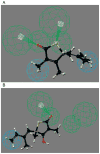Targeting the fatty acid biosynthesis enzyme, beta-ketoacyl-acyl carrier protein synthase III (PfKASIII), in the identification of novel antimalarial agents
- PMID: 19191586
- PMCID: PMC2810129
- DOI: 10.1021/jm8008103
Targeting the fatty acid biosynthesis enzyme, beta-ketoacyl-acyl carrier protein synthase III (PfKASIII), in the identification of novel antimalarial agents
Abstract
The importance of fatty acids to the human malaria parasite, Plasmodium falciparum, and differences due to a type I fatty acid synthesis (FAS) pathway in the parasite, make it an attractive drug target. In the present study, we developed and a utilized a pharmacophore to select compounds for testing against PfKASIII, the initiating enzyme of FAS. This effort identified several PfKASIII inhibitors that grouped into various chemical classes of sulfides, sulfonamides, and sulfonyls. Approximately 60% of the submicromolar inhibitors of PfKASIII inhibited in vitro growth of the malaria parasite. These compounds inhibited both drug sensitive and resistant parasites and testing against a mammalian cell line revealed an encouraging in vitro therapeutic index for the most active compounds. Docking studies into the active site of PfKASIII suggest a potential binding mode that exploits amino acid residues at the mouth of the substrate tunnel.
Figures





Similar articles
-
Lactococcus lactis fabH, encoding beta-ketoacyl-acyl carrier protein synthase, can be functionally replaced by the Plasmodium falciparum congener.Appl Environ Microbiol. 2010 Jun;76(12):3959-66. doi: 10.1128/AEM.00170-10. Epub 2010 Apr 23. Appl Environ Microbiol. 2010. PMID: 20418430 Free PMC article.
-
The initiating steps of a type II fatty acid synthase in Plasmodium falciparum are catalyzed by pfACP, pfMCAT, and pfKASIII.Biochemistry. 2003 Feb 4;42(4):1160-9. doi: 10.1021/bi026847k. Biochemistry. 2003. PMID: 12549938
-
Functional characterization of the acyl carrier protein (PfACP) and beta-ketoacyl ACP synthase III (PfKASIII) from Plasmodium falciparum.Mol Biochem Parasitol. 2002 Aug 28;123(2):85-94. doi: 10.1016/s0166-6851(02)00140-8. Mol Biochem Parasitol. 2002. PMID: 12270624
-
Fatty Acid synthesis as a target for antimalarial drug discovery.Comb Chem High Throughput Screen. 2005 Feb;8(1):15-26. doi: 10.2174/1386207053328192. Comb Chem High Throughput Screen. 2005. PMID: 15720194 Review.
-
Malaria parasite carbonic anhydrase: inhibition of aromatic/heterocyclic sulfonamides and its therapeutic potential.Asian Pac J Trop Biomed. 2011 Jun;1(3):233-42. doi: 10.1016/S2221-1691(11)60034-8. Asian Pac J Trop Biomed. 2011. PMID: 23569766 Free PMC article. Review.
Cited by
-
Metabolomics and malaria biology.Mol Biochem Parasitol. 2011 Feb;175(2):104-11. doi: 10.1016/j.molbiopara.2010.09.008. Epub 2010 Oct 21. Mol Biochem Parasitol. 2011. PMID: 20970461 Free PMC article. Review.
-
Lactococcus lactis fabH, encoding beta-ketoacyl-acyl carrier protein synthase, can be functionally replaced by the Plasmodium falciparum congener.Appl Environ Microbiol. 2010 Jun;76(12):3959-66. doi: 10.1128/AEM.00170-10. Epub 2010 Apr 23. Appl Environ Microbiol. 2010. PMID: 20418430 Free PMC article.
-
The next opportunity in anti-malaria drug discovery: the liver stage.PLoS Pathog. 2011 Sep;7(9):e1002178. doi: 10.1371/journal.ppat.1002178. Epub 2011 Sep 22. PLoS Pathog. 2011. PMID: 21966266 Free PMC article. No abstract available.
-
Apicoplast-Resident Processes: Exploiting the Chink in the Armour of Plasmodium falciparum Parasites.Adv Pharmacol Pharm Sci. 2024 May 10;2024:9940468. doi: 10.1155/2024/9940468. eCollection 2024. Adv Pharmacol Pharm Sci. 2024. PMID: 38765186 Free PMC article. Review.
-
Targeting the Lipid Metabolic Pathways for the Treatment of Malaria.Drug Dev Res. 2010 Feb;71(1):44-55. doi: 10.1002/ddr.20347. Drug Dev Res. 2010. PMID: 20559451 Free PMC article.
References
-
- Breman JG. The ears of the hippopotamus: manifestations, determinants, and estimates of the malaria burden. Am J Trop Med Hyg. 2001;64:1–11. - PubMed
-
- Fast NM, Kissinger JC, Roos DS, Keeling PJ. Nuclear-encoded, plastid-targeted genes suggest a single common origin for apicomplexan and dinoflagellate plastids. Mol Biol Evol. 2001;18:418–426. - PubMed
-
- Williamson DH, Gardner MJ, Preiser P, Moore DJ, Rangachari K, et al. The evolutionary origin of the 35 kb circular DNA of Plasmodium falciparum: new evidence supports a possible rhodophyte ancestry. Mol Genet Genomics. 1994;243:249–252. - PubMed
-
- Wilson RJ. Progress with parasite plastids. J Mol Biol. 2002;319:257–274. - PubMed
-
- Lu JZ, Lee PJ, Waters NC, Prigge ST. Fatty acid synthesis as a target for antimalarial drug discovery. Comb Chem High Throughput Screening. 2005;8:15–26. - PubMed
Publication types
MeSH terms
Substances
Grants and funding
LinkOut - more resources
Full Text Sources
Other Literature Sources
Research Materials
Miscellaneous

